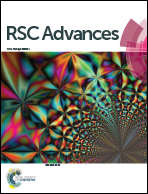Alloying of platinum and molybdenum for transparent counter electrodes. A strategy of enhancing power output for bifacial dye-sensitized solar cells
Abstract
Designing a cost-effective counter electrode (CE) with no sacrifice of photovoltaic performances and power output for a bifacial dye-sensitized solar cell (DSSC) is a persistent objective in photovoltaic power generation. We present here the fabrication of a novel transparent binary Pt-Mo alloy CE by an electrochemical strategy for bifacial DSSC application with an aim of bringing down the cost for solar-to-electric conversion. Electrochemical, and therefore photovoltaic performances, are optimized by adjusting stoichiometries of Pt-Mo alloys. Due to high charge-transfer ability, electrocatalytic activity, and optical transparency, maximum power conversion efficiencies of 6.75% and 2.89% are recorded under front and rear irradiation, respectively, which are comparable to 6.74% and 2.47% from a pristine Pt electrode-based solar cell. Due to the compensation effect of light from a transparent alloy CE to the incident light from the anode, the maximum power output of a solar cell has been markedly enhanced under simultaneous irradiation in comparison with either side. The enhanced efficiency along with enhanced power output, fast start-up, multiple start capability, simple preparation, and low Pt dosage highlights the potential application of these cost-effective transparent Pt-Mo alloy CEs in bifacial DSSCs.


 Please wait while we load your content...
Please wait while we load your content...